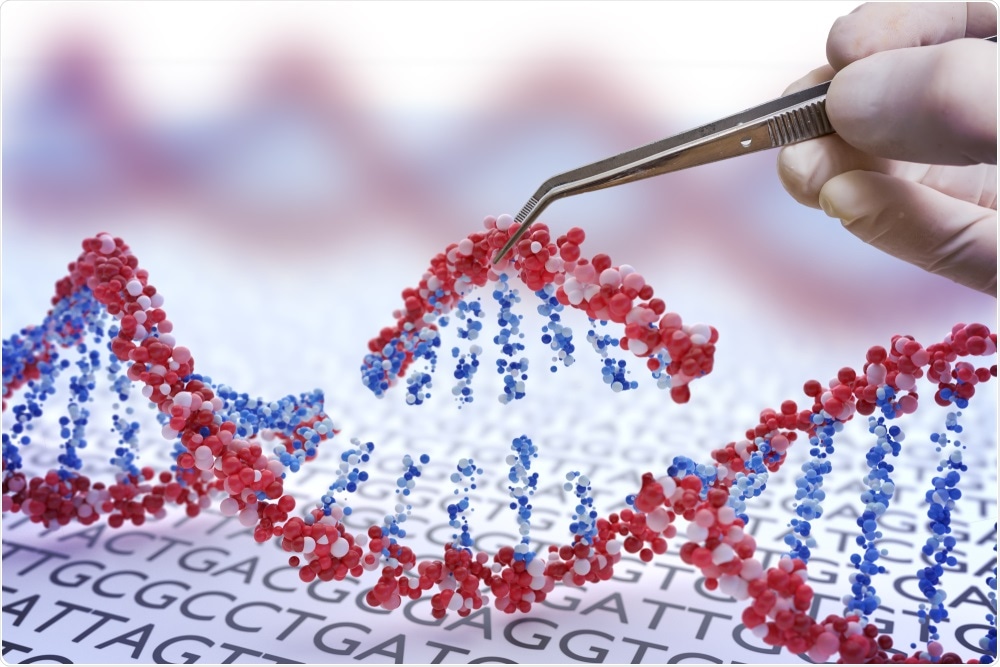For the first time, Stanford researchers have miniaturized CRISPR for mammalian gene editing, which magnifies the scope of CRISPR technology.

CRISPR. Image Credit: vchal/Shutterstock.com
Harnessing the multiplicity of CRISPR technology
CRISPR gene editing is often perceived as molecular scissors cutting targeted DNA sections, but a Swiss Army knife may actually be more accurate says Stanley Qi, assistant professor of bioengineering at Stanford University.
“CRISPR can be as simple as a cutter, or more advanced as a regulator, an editor, a labeler, or imager. Many applications are emerging from this exciting field,” describes Qi, also posted as assistant professor of chemical and systems biology at the Stanford School of Medicine and a Stanford ChEM-H institute scholar.
Since its inception, CRISPR systems have diversified and many versions are in use or being clinically tested for gene therapy to treat diseases in the eye, liver, and brain. However, existing versions are all limited by a predominant factor. That is, they are all too large, making them difficult to deliver into cells, tissues, or living organisms, effectively.
Now, Qi and his collaborators have achieved a breakthrough with the development of an efficient, for mammalian gene editing. Presenting their findings in a study published in the journal Molecular Cell, the team demonstrates the efficiently designed CasMINI.
Making a miniature CRISPR to expand its applications
Cas9 and Cas12a are known systems that are named thanks to their versions of CRISPR-associated proteins, and they are made of between 1000 and 1500 amino acids. The new CasMINI, however, has only 529.
This smaller size means it is easier to deliver into tissue and cells, providing unprecedented technology for treating diverse ailments including eye diseases, organ degeneration, and genetic diseases generally.
To achieve this miniaturization, researchers began with CRISPR protein Cas12f (also referred to as Cas14), because it contains only about 400 to 700 amino acids. Cas12f natural originates from Archaea, which are single-celled organisms, making the system not particularly well suited for mammalian cells such as human ones.
The challenge was therefore to find CRISPR protein to work in mammalian cells without any modification, and Cas12f is not one of those.
We thought, ‘Okay, millions of years of evolution have not been able to turn this CRISPR system into something that functions in the human body. Can we change that in just one or two years? To my knowledge, we have, for the first time, turned a nonworking CRISPR into a working one.”
Qi
The lead author on the paper, Xiaoshu Xu, who is a postdoctoral scholar in the Qi lab, found no activity of Cas12f in human cells, making Xu and Qi hypothesize that human genome DNA is more complicated and less accessible than microbial DNA, making it hard for Cas12f to find its cellular target.
Xu then chose about 40 mutations of the protein to bypass this limitation using the computationally predicted structure of the Cas12f system. The system tested many protein variants simultaneously, and a working variant would be found when a human cell would turn green through the activation of the green fluorescent protein in its genome.
“At first, this system did not work at all for a year,” Xu said. “But after iterations of bioengineering, we saw some engineered proteins start to turn on, like magic. It made us really appreciate the power of synthetic biology and bioengineering.”
Comparable gene activation between CasMINI and Cas12a
At first, results were modest, but as the system worked and iterations were made, Xu was able to gradually improve the protein’s performance.
“We started with seeing only two cells showing a green signal, and now after engineering, almost every cell is green under the microscope,” Xu said. “At some moment, I had to stop her,” recalled Qi. “I said ‘That’s good for now. You’ve made a pretty good system. We should think about how this molecule can be used for applications.’”
The researchers also redesigned the RNA guiding the Cas protein, modifying both components which allow CasMINI to work in human cells effectively. Tests were conducted to examine the ability of CasMINI’s to delete and edit genes in lab-based human cells, including genes related to HIV infection, anti-tumor immune response, and anemia.
Results showed that CasMINI worked on almost every gene they tested, and so the researchers pursued additional gene therapies to test the limits of the new system, which are currently underway.
In addition to testing the system, the team is interested in how this could progress RNA technologies in similar ways to the mRNA COVID-19 vaccines since size also remains a limiting factor.
This ability to engineer these systems has been desired in the eld since the early days of CRISPR, and I feel like we did our part to move toward that reality, and this engineering approach can be so broadly helpful. That’s what excites me – opening the door on new possibilities.”
Journal reference:
- Xu et al., 2021, Molecular Cell 81 , 1–13 October 21, 2021 ª 2021 Elsevier Inc. https://doi.org/10.1016/j.molcel.2021.08.008 ll